Get the week's most popular posts delivered to your inbox.
Our weekly update is free yet priceless and you're less than a minute away from getting the current edition.
In the unlikely event we disappoint, you can unsubscribe with a single click!
Last Updated on February 12, 2025 by teamobn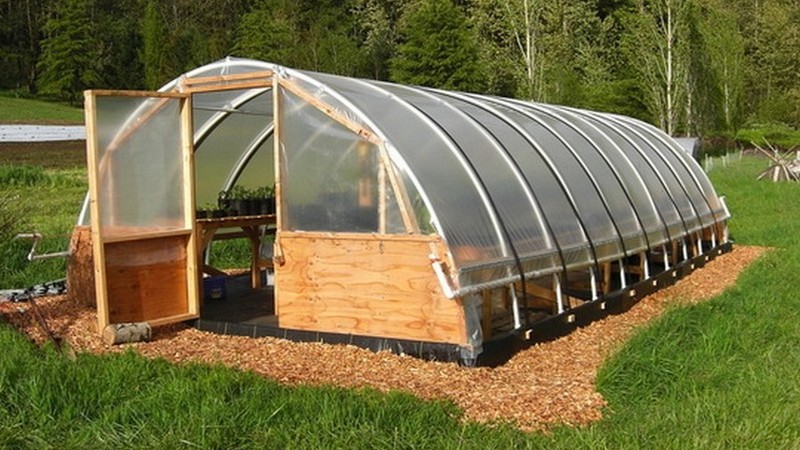
DIY Hoop Greenhouses are a great way to extend your vegetable growing season in a cold climate. Building your own can help you save a lot of money as well as allow you to customize the size to suit your needs.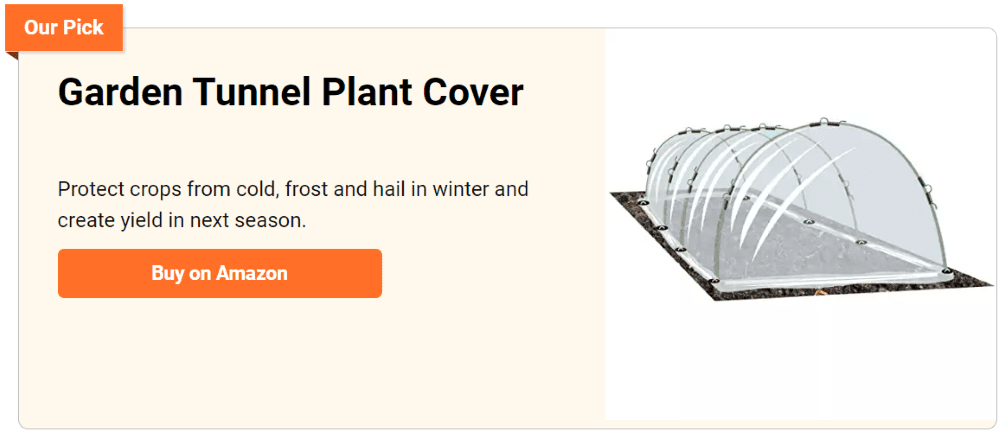
This greenhouse is built for starting seedlings, technically known as a propagation house. But what is great about it is that it’s made from PVC and wood, which are materials that are cheap and easy to find.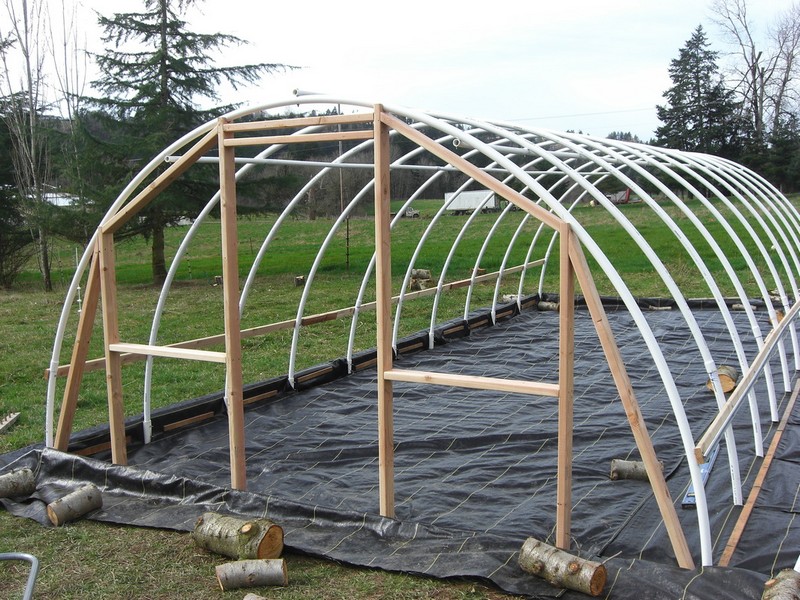
Even though it’s made from simple and inexpensive materials, it can grow a wide range of produce, even during the season not ideal for growing crops.
Building a Hoop Greenhouse
Pressure-treated lumber (PTL) is a wood product that contains preservative chemicals, which prevent wood rot. PTL is a good choice for DIY projects, as it is highly resistant to rot and insects. However, these chemicals are toxic, so it’s important to understand how PTL is made, and what these chemicals do.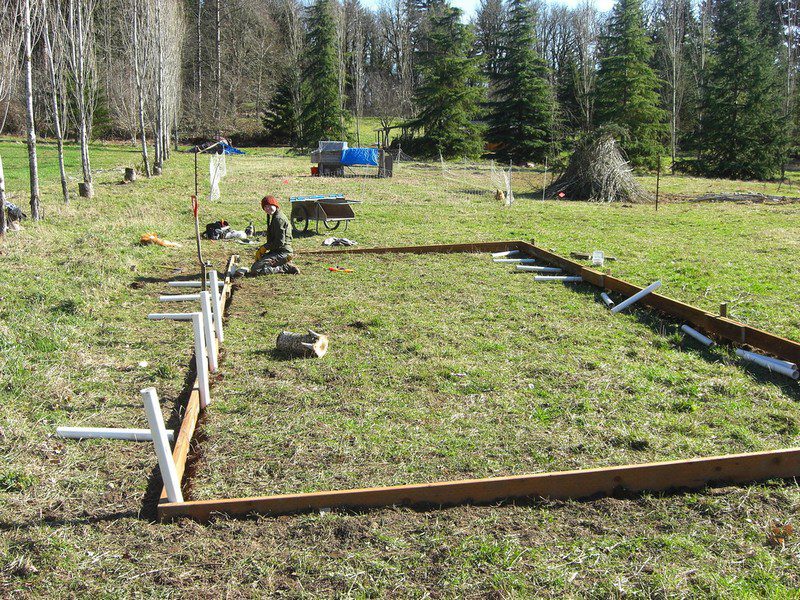
You can create a hoop house out of one or two levels of PVC pipe. You can buy PVC pipe at most hardware stores or perhaps see if you have some already.
You should use at least a 1-inch diameter of PVC Pipe. You can buy it in 10 ft sections, which is usually enough. PVC pipe is a great choice for a hoop-style greenhouse.
Its lightweight and durability mean you can create a hoop structure that is strong enough to support your plants, but not so heavy that you can’t move it around or disassemble it when you need to.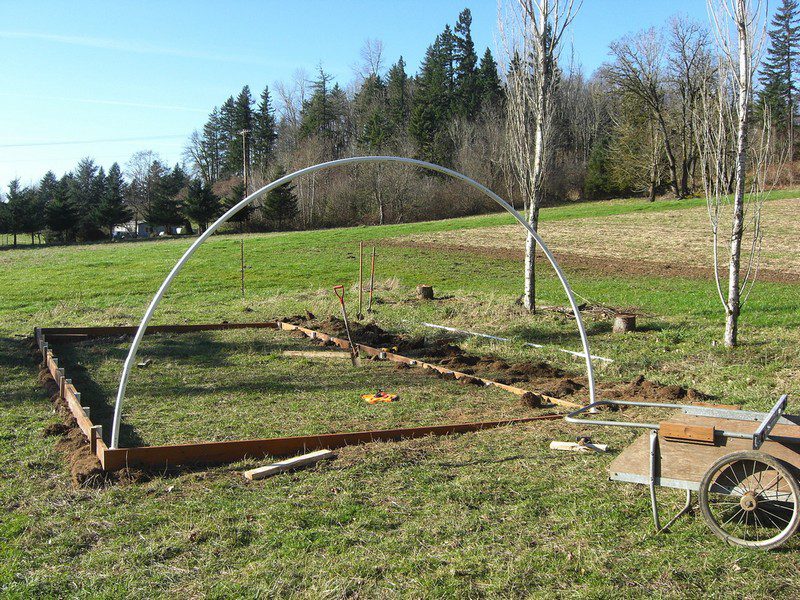
The reason you should choose a pipe of this size was that you would want it to be able to be used inside the hoop so that you could rotate the pipe in and out of the structure as the plants grew and grew. You would also want to be able to slip 2 pipes into the structure to create a 2-level hoop structure.
You can bend the pipe with a hose clamp (widely available) or a pipe bender (a tool that creates a smooth curve in the pipe, I think it’s available at most hardware stores).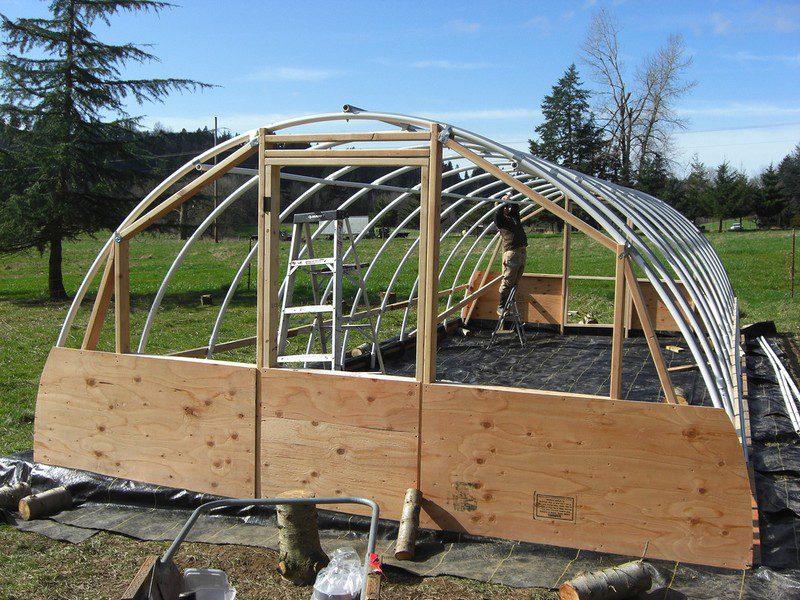
Hoop house greenhouse roofs can be made of many different things. The most common ones are plastic, metal or fibreglass. While fibreglass is often used due to its lightness, it can be quite expensive and an inferior choice, as it needs to be covered with something to keep it from getting wet.
You may also want to buy some poly-plastic sheeting as an alternative, some of that is the size of your pipe. In order to make it easier for plants to grow in your DIY hoop greenhouse, plastic is wrapped around the frame. This can make work easier when it is time to take away the plastic.
You may also want some plastic hooks and some zip ties, they will put things in order for your DIY hoop greenhouse.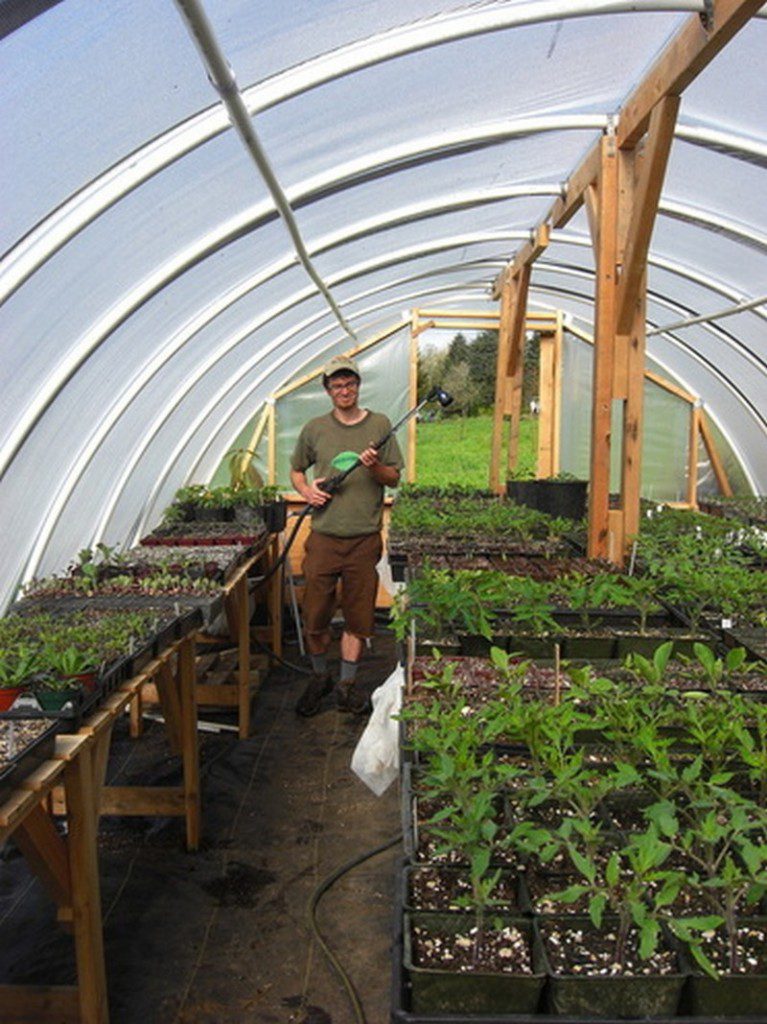
Materials:
- 2 x 6’ Pressure Treated Lumber – the foundation
- 2” x 4” Pressure Treated Lumber
- 24” long 2” PVC
- 23’ long 1-1/4” PVC Bows
- 5” Carriage Bolts
- 4” Carriage Bolts
- Metal Strapping
- Duct Tape
- Six-mil Poly Plastic
- Batten Strapping
Tools:
- Sledge Hammer
- Electric Drill (with Graduated Drill Bit)
- Channel Locks
- Hole Saw
- Scissors
Click on any image to start the lightbox display. Use your Esc key to close the lightbox. You can also view the images as a slideshow if you prefer 😎



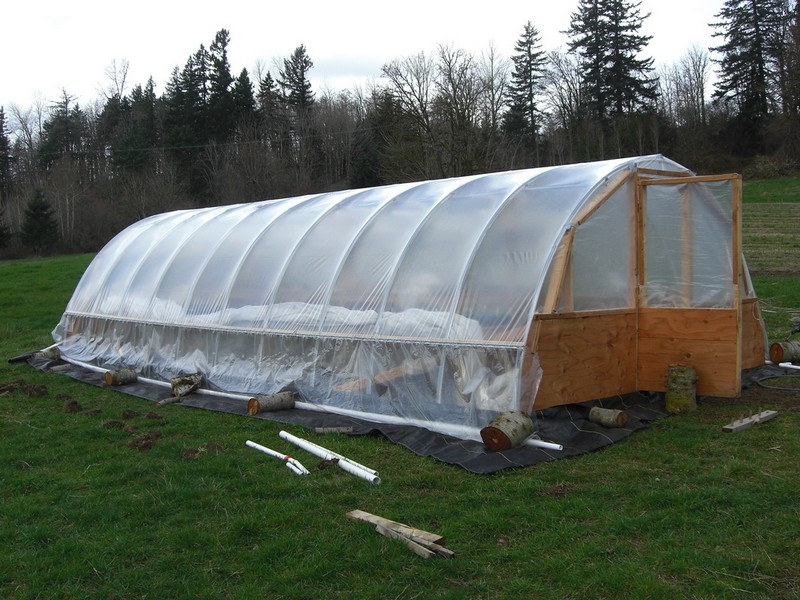
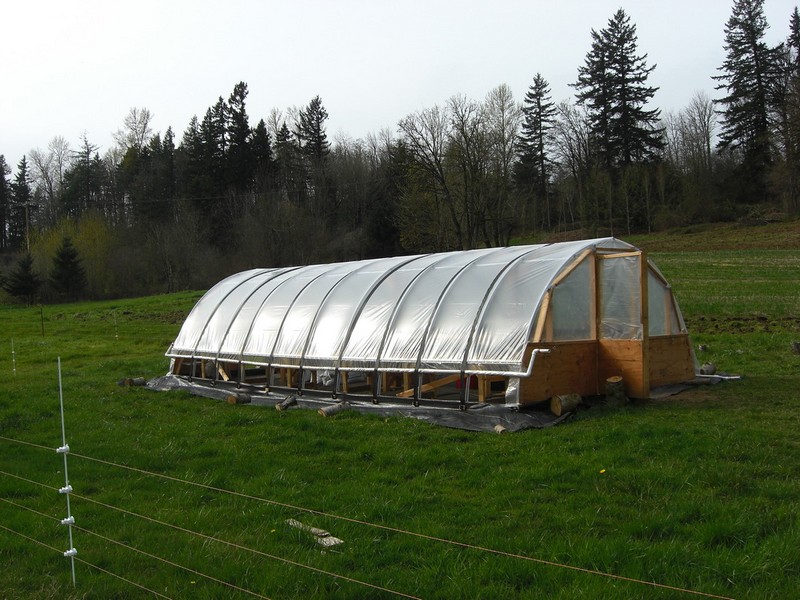
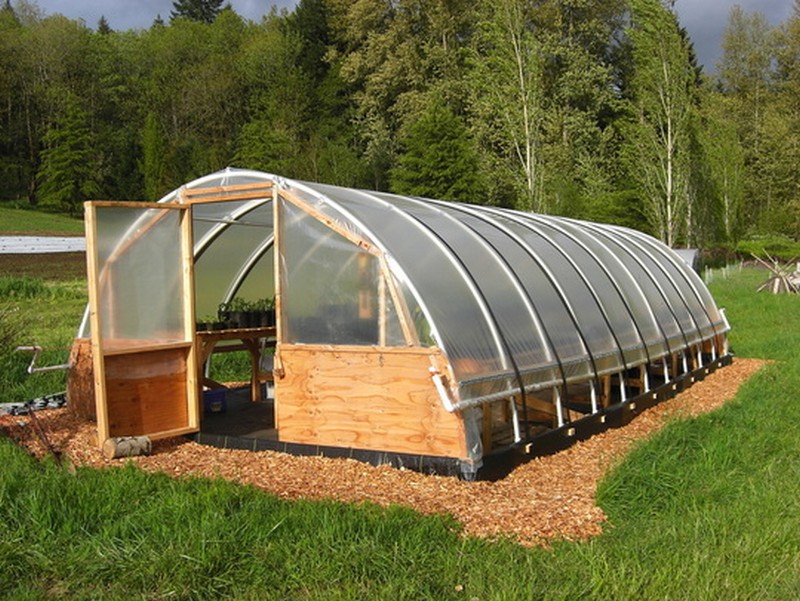
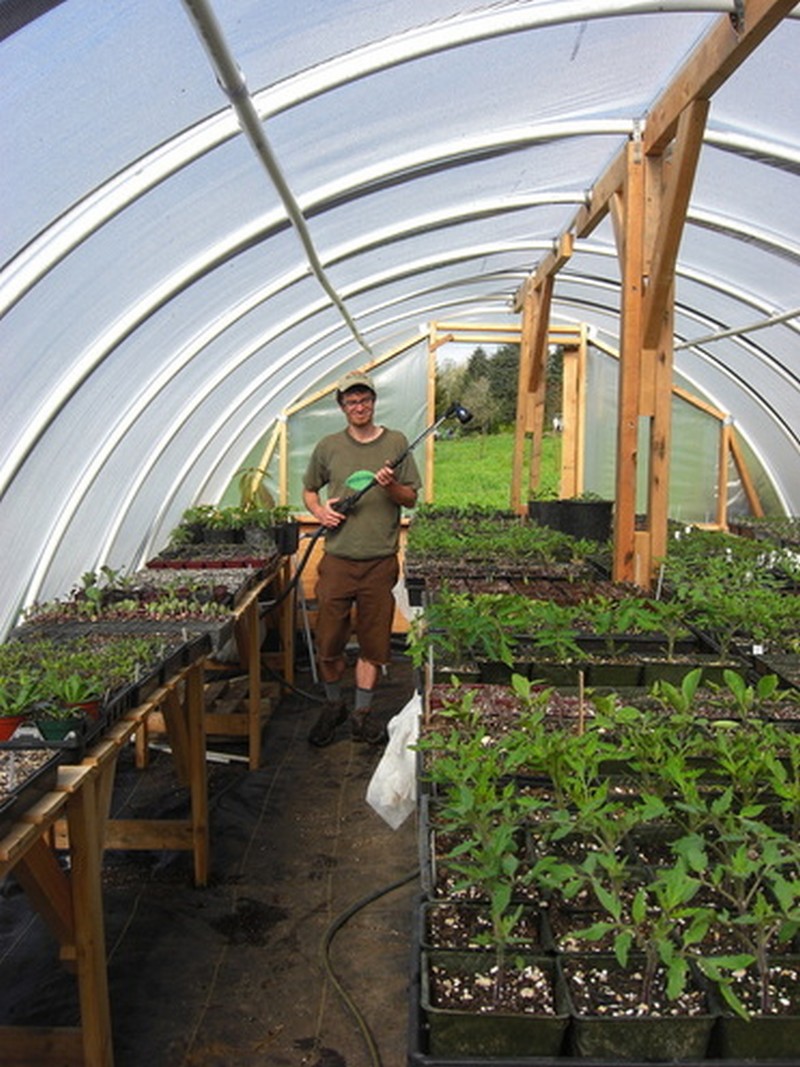
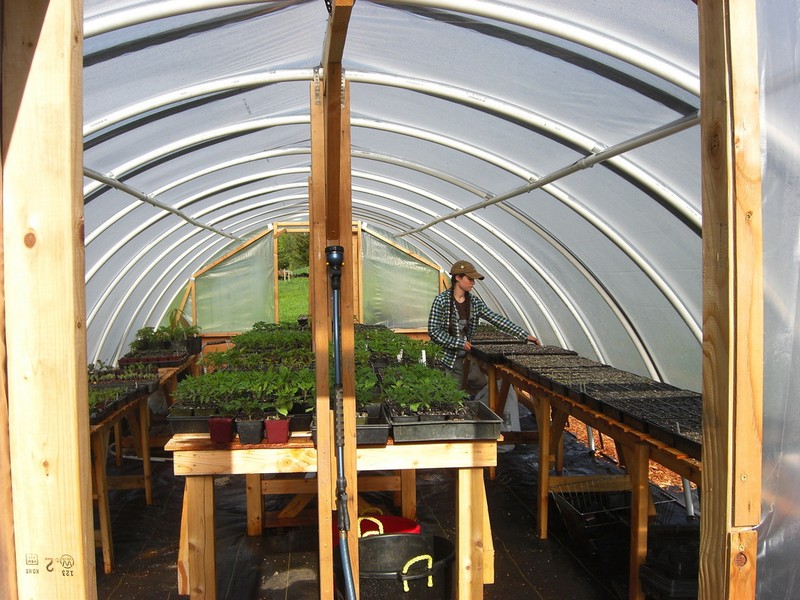
Thanks to Fiddle Head Farmers for this great project. You can get step-by-step instructions here…
Optimizing Internal Layout and Spacing
Optimizing the internal layout and spacing of your hoop greenhouse is crucial for maximizing plant growth and ensuring efficient use of space. This guide will explore various techniques to arrange your hoop greenhouse for optimal results.
Maximizing Vertical Space
In a hoop greenhouse, vertical space is often underutilized. Installing shelving systems or creating hanging plant setups can dramatically increase the amount of usable growing area. Vertical farming not only saves floor space but also makes watering and harvesting more accessible. Consider using stackable and adjustable shelving units to accommodate plants of different heights.
Strategic Plant Spacing
Proper plant spacing is essential for healthy growth. In the confined space of a hoop greenhouse, it’s important to balance the number of plants with their mature sizes. Utilize spacing guides for specific vegetables or flowers to ensure that each plant receives enough light and air circulation. This strategic spacing helps prevent the spread of diseases and minimizes competition for nutrients.
Utilizing Table Space for Seedlings
For those starting plants from seeds, dedicating a portion of your hoop greenhouse to flat tables can be beneficial. These tables provide a controlled environment for germinating seedlings. Once the seedlings are robust enough, they can be moved to their final positions within the greenhouse. This method helps streamline the workflow from seed to mature plants.
You can create a more productive and manageable hoop greenhouse environment by carefully considering each aspect of the internal layout and spacing. These adjustments not only optimize the growing conditions but also enhance the overall functionality of the space.
Climate Control Solutions
Effective climate control is pivotal for maximizing plant growth and health in a hoop greenhouse. Here, we explore several strategies to maintain optimal temperature and humidity levels, ensuring your plants thrive throughout the year.
Regulating Temperature with Shade Cloths and Ventilation
Using shade cloths can significantly lower temperatures inside your hoop greenhouse during the hotter months. These cloths can be easily draped over the greenhouse structure to provide shade without obstructing light completely. For natural ventilation, install manual or automatic vent openers at strategic points to allow hot air to escape and cooler air to enter, balancing the internal climate.
Humidity Management through Ventilation and Watering Techniques
Managing humidity is crucial to prevent disease and ensure plant vigor. Enhance airflow with fans or additional vents to reduce excess moisture and condensation. Also, adjust your watering schedule to early mornings, which helps plants absorb water throughout the day and decreases humidity levels at night.
Using Thermal Mass for Heat Regulation
Incorporating materials with high thermal mass, such as water barrels or concrete floors, can stabilize temperature fluctuations. These materials absorb heat during the day and release it slowly when temperatures drop, providing a more consistent environment inside the hoop greenhouse.
Implementing these climate control solutions will help maintain a stable environment within your hoop greenhouse, promoting healthy plant growth and extending the growing season.
Pest Management
Managing pests effectively is crucial for maintaining the health and productivity of your plants within a hoop greenhouse. Here, we explore several strategies to keep pests at bay and ensure your greenhouse remains a thriving environment for plant growth.
Natural Pest Control Methods
Integrating natural pest control methods is a sustainable approach to managing infestations. Introduce beneficial insects, such as ladybugs and lacewings, which prey on harmful pests like aphids and mites. Additionally, planting pest-repellent herbs, such as basil and mint, around the perimeter of your hoop greenhouse can naturally deter pests.
Physical Barriers and Traps
Employing physical barriers such as insect netting can effectively prevent pests from accessing your plants. Ensure the netting is fine enough to block common pests while allowing light and air to reach the plants. Additionally, sticky traps and pheromone traps can be used to capture and monitor pest populations within the hoop greenhouse.
Regular Monitoring and Hygiene
Regular monitoring is key to early pest detection and management. Inspect your plants frequently for signs of infestation, and remove any pests or infected plant parts promptly. Keeping the hoop greenhouse clean and free from debris can also minimize pest breeding grounds and reduce the likelihood of disease spread.
Companion Planting
Companion planting involves placing certain plants together that naturally help each other thrive or deter pests. For example, marigolds emit a scent that repels nematodes and other pests, making them excellent companions for most vegetables. Garlic and chives can help deter aphids, providing a natural and effective barrier against these common pests.
Soil Health Management
Maintaining healthy soil is fundamental to preventing pest infestations. Healthy soil supports strong plant growth, which is less susceptible to pests. Regularly amend your soil with compost and ensure proper drainage to prevent waterlogged conditions, which can attract pests and facilitate disease.
Biological Pest Controls
Introduce biological pest controls, such as nematodes, which are beneficial organisms that attack and control pest populations like soil-dwelling larvae and grubs. These biological agents provide a natural way to control pests without the need for chemical pesticides.
Proper Watering Techniques
Avoid overhead watering which can create moist conditions that attract pests and foster disease. Instead, use drip irrigation or soaker hoses that deliver water directly to the soil and roots. This method reduces excess moisture on plant foliage and helps prevent the spread of leaf-borne diseases.
Crop Rotation
Rotate your crops annually to prevent pests that target specific plants from establishing themselves in the soil. Crop rotation disrupts the life cycles of pests, reducing their numbers and impact on your plants.
Implementing these additional pest management tips will further enhance your ability to maintain a healthy and productive hoop greenhouse environment.
Conclusion
Building a hoop greenhouse is a rewarding endeavor that enhances your gardening capabilities, allowing you to grow a diverse array of plants year-round. By carefully managing the internal climate, optimizing space, and employing effective pest control strategies, you can create a resilient and productive environment. This DIY project not only saves money but also provides the satisfaction of cultivating your own produce in a sustainable way.
If you liked this project, you will also like viewing these gardening ideas…
Get the week's most popular posts delivered to your inbox.
Our weekly update is free yet priceless and you're less than a minute away from getting the current edition.
In the unlikely event we disappoint, you can unsubscribe with a single click!






